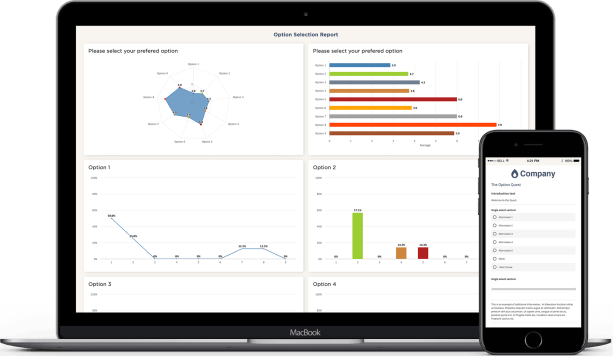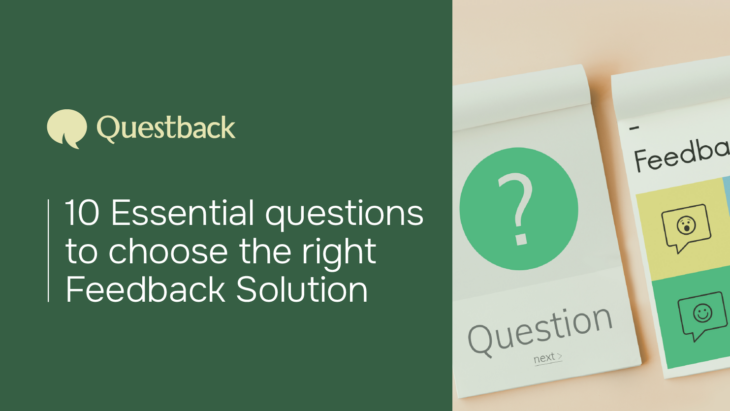360 Feedback Survey – The Complete Guide


Collecting 360 feedback (360-degree feedback) is a proven approach to measure and improve employee competencies and increase organizational outcomes.
This guide covers everything you need to know about 360 feedback surveys, including their wide-ranging benefits, the competencies a feedback survey addresses, and why automation increases the likelihood of 360 feedback success. You will also discover several evidence-based best practices when implementing 360 feedback to help your employees and managers develop and improve their performance.
Table of Contents
- What is a 360° Feedback Survey?
- The Benefits of 360 Feedback Surveys
- The Advantage of Automating the 360 Feedback Process
- What Competencies Do 360° Surveys Focus on?
- How to Write Good 360° Feedback Questions
- Why Open-ended Questions in 360 Feedback Reviews are Useful
- Best Practices in Delivering 360° Survey Results
- Final Note
What is a 360 degree Feedback Survey?
A 360 feedback survey, also called a 360 survey or a 360 review, is an insight process that collects feedback on employee performance from different sources. Feedback sources are typically internal, including managers, subordinates, peers, and self-assessment, but can also be sourced from external stakeholders where an employee regularly interacts with the public, such as clients, suppliers, vendors, or contractors.
The purpose of 360 surveys is to transform feedback into improvements to increase both employee performance and organizational outcomes. With this in mind, a 360 feedback approach enables employees at every level of an organization to drive and monitor progress over time.
Research consistently shows that 360 surveys, if done well, develop high-performing employees, stronger teams, and better organizational outcomes. 360 feedback surveys are popular among businesses, large or small, because they deliver a wide range of proven benefits.
Try Questback 14 days for free.
The Benefits of 360 Feedback Surveys
There are many benefits to deploying 360 feedback surveys in your organization. These benefits are multilevel—employees, management, and organizational.
From an employee’s perspective, there are three main benefits:
- Enhanced self-awareness. Research shows that people tend to lack self-awareness—only around 15% of us possess genuine self-awareness. Therefore, to build and benefit from self-awareness, employees need to understand how others perceive them to develop and enhance an accurate, authentic understanding of how they perform from different perspectives.
- Increased accountability for improvement. Employees receive 360 feedback results and gain insights into their attributes, competencies, and performance. They also get insight into how their systems work, which involves seeking feedback about how their, HR-system, time management system and payroll software works for their employees. This transparency creates accountability for change and the need to improve.
- Better career development opportunities. Feedback surveys enable career development opportunities to emerge. For instance, if management and peers consistently identify an employee as holding significant potential, this will likely highlight career opportunities to get promoted and progress in their career.
From a manager’s perspective, there are four main benefits:
- Gain a broader perspective on employee performance. While a manager regularly interacts with employees who report to them, they lack an overall view. With insights from others who interact with the employee, a manager gains a broader perspective on an employee’s attributes and how well the employee performs on various tasks and projects.
- Identify and close performance gaps. It is not only the employee who benefits. Their manager will also quickly identify the gaps in the employee’s performance. More importantly, the manager can also discern and coach the skills needed to close performance gaps.
- Enhance teamwork capabilities. A manager will likely have several employees who report to them. With 360 feedback surveys, a manager will benefit from collective employee improvements to enhance teamwork efforts and outcomes.
- The advantage for a manager getting feedback from direct reports. To become a great manager, the manager needs self-awareness of how their direct reports perceive the leadership style. To develop as a manager, it is crucial to get this information to improve leadership. This is also highly important for employee engagement.

From an organization’s perspective, there are several benefits as well:
- Gathers broad and deep insights. As mentioned, 360 feedback enables broader perspectives. Yet, at an organizational level, 360 reviews achieve breadth and depth of insights. Organizations can swiftly identify and address issues, opportunities, and underlying causes.
- Visualizes progress over time. By gathering 360 feedback across different employee levels over time, an organization can visualize data, and its trends, for better or worse, over time. This bird’s eye view is an effective means to visualize organizational performance trends over time.
- Impact on measurable outcomes. The goal of 360 feedback is to improve employees, including leadership effectiveness, producing measurable impacts on organizational outcomes. For instance, research shows that leadership effectiveness is linked with employee retention, increased customer satisfaction, greater profitability, productivity, and employee engagement.
These wide-ranging benefits, however, are better realized, as highlighted below, if your organization automates the 360 feedback process.
The Advantage of Automating the 360 Feedback Process
Unlike single indicators, such as the Net Promoter Score, the 360 Process is more complex—it involves multiple steps and many people. Therefore, automating wherever possible is advantageous to make the 360-review process as efficient as possible.
A 360 feedback solution such as Questback is the most efficient process to save your business time and money and gain the best insights to realize the many benefits outlined previously.
So what steps are taken in the 360-feedback process, and which ones can be automated? Below we share eight steps your organization can take to ensure the best results.
Step 1: Communicate the 360 Launch.
Awareness is necessary to ensure employees accept and are responsive to 360 feedback. It’s always best to prepare employees by informing and preparing all those involved before implementation. This step needs to be fully transparent and aims to build trust and buy-in among staff. We recommend allowing sufficient time to address queries and concerns and, importantly, communicate the whole process, from start to finish, and the timelines involved.
Step 2: Select raters.
At Questback, we advise only selecting raters with sufficient professional experience with the employee to ensure accurate feedback. Each employee also needs diverse perspectives to capture the different work functions they perform. Concerning the number of raters, like any sampling, you need confidence in the results—research suggests that ten raters are best to achieve an acceptable level of reliability. As to who chooses the raters, we advise allowing the ratee to nominate some of their raters while stipulating that all direct reports must include their manager. Significantly, allowing ratees to choose some of their raters will increase the acceptance of 360 reviews.
Step 3: Distribute 360 surveys.
Automating this process with a solution like Questback is hugely important to ensuring the efficient and quick distribution of surveys. This step typically involves an email invitation to each rater and ratee for self-assessment. Effective email notifications contain clear instructions on how to start and complete the 360-feedback process. Raters can receive different emails with multiple colleagues to evaluate. Therefore, it should be specified in the email invitation which colleague it concerns, and with the name visible in each question as well.
Step 4: Completing the 360 surveys.
This step requires sufficient time to allow those involved to provide accurate and informative feedback. To ensure surveys are completed promptly, establish and remind raters of the deadline.
Step 5: Automate reports.
Again, automation is highly recommended to facilitate the rapid and accurate compilation of 360 reports. Using a solution like Questback will save your business significant time as automation will produce feedback reports to all involved.
Step 6: Arrange and conduct feedback meetings.
Confidential discussions with ratees are essential to ensure feedback is discussed and development opportunities are identified. Again, allow sufficient time at meetings (one to two hours) between the ratee and the manager or coach to enable the best outcomes.
Step 7: Complete the development plan.
The core purpose of a 360 review is to leverage feedback to produce better outcomes for the employee, manager, team, and organization. Given this goal, a development plan is needed to facilitate these improvements. This step demands critically reflecting on feedback findings and identifying opportunities to build on strengths and overcome weaknesses.
Step 8: Repeat to measure progress.
360 feedback surveys are not a one-off event. To genuinely benefit from the process, it’s essential to identify timely intervals to track progress over time. 360 reviews are typically repeated over consistent intervals, e.g., between 8 and 12 months.
Now that we know what the 360-review process involves, we focus next on the content of the 360 feedback surveys.
What Competencies Do 360 Surveys Focus on?
The competencies your business focuses on will depend on your sector, strategic goals, and organizational culture. It is always beneficial to scope out which core competencies are most important for your business early on.
Scoping out and planning which competencies should be included will likely involve discussions, including focus groups, to identify which competencies are your priority. Nonetheless, they will likely be focused on different areas, such as:
- Personal attributes, e.g., self-awareness
- Interpersonal qualities, e.g., communication
- Results and outcomes, e.g., performance
- Strategic direction, e.g., managing change processes
When you initially scope out competencies, you will likely generate a long list of desirable attributes, qualities, outcomes, and directions. However, too many will result in a long feedback survey, risking survey fatigue. This is particularly the case with feedback reviews, as raters will probably complete several surveys for different employees.
At Questback, we recommend limiting your total number of competencies to no more than 10. This limit also focuses employees on which competencies are most strategically valued by your business.
Once you’ve built a competency model outlining different attributes and outcomes, you can focus on which questions are most relevant to measure each competency. Again, to reduce the risk of 360 survey fatigue, we recommend that you limit the total number of feedback questions to around 30 to 40 per survey. It is crucial to use logic in the questionnaire and only ask questions that the rater can answer, i.e., it differs if you are a peer or subordinate what questions you can answer if you want to evaluate the employee’s leadership for example.
At Questback, we also recommend customizing questions to role types and position levels. It’s unlikely that all questions will be relevant to everyone employed in your business.
Therefore, when designing and planning your 360 reviews, it is essential to map out which competencies are must-haves, and which specific questions are best at measuring these competencies for different employees. In this regard, it is paramount that questions are framed well to generate valid and accurate assessments, discussed next.

How to Write Good 360 Feedback Questions
Poorly designed 360 feedback surveys will degrade your data’s meaning and value. Worse, if ill-framed questions generate invalid results, this mistake risks creating distrust among staff. Therefore, the success of your 360 reviews also depends on the design and framing of your feedback questions.
Framing feedback questions well involves ensuring each question is unbiased, fair, and non-judgmental. Notably, the rating scale should also allow a range of responses. How the rating scales should be framed also depends on your goal.
Performance consistency will likely be measured if your 360-review focus is professional development. For instance, you could use a 5-point scale, from ‘Always’ to ‘Never’. If the focus is appraisal, a comparative approach may be better. For instance, the response 5-point scale offered to raters could range from ‘Among the top 10%’ to ‘Among the bottom 10%’ to allow employee comparisons.
Craft the question, so it only measures one competency, as double-barreled questions are misleading. On this point, always test whether questions are unambiguous, clear, and not complicated to understand.
While the above gives tips for framing and designing questions, it’s always best to draw on experts with 360 survey knowledge to create a robust 360 instrument. With a solution like Questback, our expert team advises and constructs surveys that meet high standards. This advice ensures validity and accuracy to help you gain the most value from your 360 reviews. And among our recommendations is to complement structured questions with open-ended questions, discussed next.
Why Open-ended Questions in 360 Feedback Reviews are Useful
While structured questions provide a rapid means to gather insightful data, open-ended questions allow rich insights into the ‘why?’ behind rating responses. This is valuable as improvement is the purpose of 360 reviews, and knowing the why will help employees, managers, and your organization implement changes.
Whether or not you make your open-ended questions mandatory to answer, it’s good to consider where and how these open questions will be asked.
For instance, after an immediate structured question, you could ask: ‘Please elaborate on your answer.’ In addition, at the end of your feedback survey, you could ask: ‘What else would you like to share about this employee?’ or ‘Could you provide specific examples to elaborate on your response(s)?’
Open-ended questions can also provide a means for raters to contribute their ideas. For example: ‘In what ways can (employee name) improve?’
Now that we’ve laid the foundations on what 360 surveys involve, it’s important to highlight areas of best practice to benefit from this insightful process fully.
360 Feedback Survey

Use 360 feedback surveys to figure out what drivers that lead to high engagement
In this whitepaper, you will find 33 concrete tips that you can act on to immediately increase employee engagement at your workplace.
Best Practices in Delivering 360 Survey Results
Both research and our extensive experience at Questback demonstrate several best practices you can implement to deliver successful 360 reviews. Below are ten suggestions to maximize the success of your 360-feedback review system.
- Develop a feedback culture. As employee trust, engagement and change are essential, it’s crucial to invest the time and resources to develop and maintain a healthy feedback culture.
- Achieve buy-in early. From the start, gaining buy-in from all relevant stakeholders and the leadership team is essential to ensure high engagement rates. This early buy-in will increase your chances of successful implementation.
- Be goal-driven. It’s essential to be clear on the core purpose of your 360 reviews. As mentioned above, it can be development or appraisal based. Once clear, the design of your whole 360 approach will be far more effective.
- Measure success. How will you know if your 360-review system is successful? Start with the end in mind—how will you evaluate the success of your program? Will you measure participation rates? Or will you gather feedback—qualitative and quantitative—on the feedback process? Focus on the gap between self-rating and other rater’s perceptions in the reporting.
- Invest in training. Giving and receiving feedback well is a skill. We recommend staff training to ensure your system captures accurate, well-delivered feedback.
- Communicate regularly. The more aware employees are of your 360 processes and the benefits it brings, the higher the engagement rates. Therefore, it’s best to communicate regularly and promptly, including the timely delivery of results.
- Align strategically. As suggested earlier, aligning competencies and feedback results with your strategic goals and values is essential. The more this alignment is explicitly stated, the better the outcomes.
- Ensure anonymity. Accurate results demand honest feedback. To increase accuracy, we recommend keeping all responses, wherever possible, anonymous. Be clear what is the lowest number of groups that will be published. Most often, results for each rater group are presented separately, i.e., Manager, peers, etc. in this case, the manager’s response is not kept anonymous
- Embed 360 reviews. A 360 survey is not a one-off event: it’s part of your commitment to maintaining and improving the employee experience and organizational outcomes. With a solution like Questback, you can fully integrate your 360 reviews with other employee experience metrics to gain the full picture.
- Customize your 360 programs. As your business is unique, your feedback system is best customized to your business. This could be anything from the tone of voice to the survey branding. At Questback, we ensure that 360 solutions are a good fit for the business.
Final Note
Well-rounded, accurate feedback is made possible with 360 feedback surveys. In this guide, we covered the key considerations to make your 360 reviews successful and ensure the best outcomes for your business.
FAQ
Unlike single indicators, such as the Net Promoter Score, the 360 Process is more complex—it involves multiple steps and many people. Therefore, automating wherever possible is advantageous to make the 360-review process as efficient as possible.
A 360 feedback solution such as Questback is the most efficient process to save your business time and money and gain the best insights to realize the many benefits outlined in this guide.
The purpose of 360 surveys is to transform feedback into improvements to increase both employee performance and organizational outcomes.
A 360 feedback survey, also called a 360 survey or a 360 review, is an insight process that collects feedback on employee performance from different sources. Feedback sources are typically internal, including managers, subordinates, peers, and self-assessment, but can also be sourced from external stakeholders where an employee regularly interacts with the public, such as clients, suppliers, vendors, or contractors.
Learn more in our complete guide!

Try Questback
Questback is a leading Customer and Employee Experience solution that makes it easy to collect, analyse and take action on key stakeholder insights.










